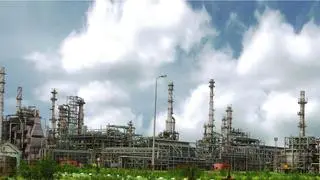Mahindra & Mahindra will launch its first BS-VI compliant petrol vehicle by the end of the second quarter this year. The diesel option is set to follow by late December or early January. The Bharat Stage VI (or BS-VI) emission norms will come into force across the country from April 1, 2020.
“There never was a doubt that we need to have a cleaner environment (and) there was never a doubt that we need to have cleaner vehicles with higher level of emission standards. The only thing the industry was concerned about was skipping BS-V (skipping one emission level was never done before) and also the timeline that was given, which was about four years for bringing in BS-VI,” said Pawan Goenka, Managing Director, M&M, speaking to reporters here on Monday.
Currently, the automobile industry in the country conforms to the BS-IV emission standards. M&M has invested ₹1,000 crore for the transition to BS-VI norms.
Goenka said that Mahindra is fully ready for BS-VI and is working with Indian suppliers, using indigenous technology and frugal engineering for BS-VI implementation within the stipulated time frame.
However, this wasn’t devoid of challenges. Goenka said that Mahindra’s engineers and their good team work with suppliers and consultants helped ensure there there would be no compromise on fuel efficiency, performance, drivability and NVH – as was feared – while explaining how the transition had seemed an insurmountable challenge, especially for an Indian company with Indian resources.
“The BS-VI compliance (of Mahindra) is a story as much of technology, planning, and programme management as (it is) a story of the determination of the 700-strong team that has worked for the past 3.5 years to make BS-VI happen along with the Mahindra suppliers and consultants,” said Goenka.
The localisation target
The localisation level for ensuring the transition is 99 per cent, exceeding the localisation target it had set, and if the sourcing by the component vendors is to be taken into consideration, the figure stands at 80 per cent, he said. Mahindra’s R&D hub in Chennai, MRV, has filed over 30 patents for the BS-VI transition. 125 vendors and 32 technology providers are part of the BS-VI programme.
Mahindra will also have a portfolio of globally competitive petrol engine vehicles, which was a challenge, particularly because Mahindra has been traditionally known more for its diesel engines, compounded by the fact that it did not even have petrol vehicles at the time of announcement of BS-VI. The other main challenge faced by the company was to ensure it meets the time target and a competitive cost, especially for the diesel portfolio.
Goenka said that the cost increase owing to the transition wouldn’t increase as much as it is believed to be. The cost target set by the Mahindra team was .6X of a European model, with the team managing to have achieved .5X, he said.
He also said the company will have no technical risks in ensuring the compliance of BS-VI and that this transition would also imply better products, contrary to the fear of compromise that was prevalent.
M&M has decided to discontinue its 1.2 litre diesel unit in the KUV 100, similar to what other players have also announced as the cost increase in this category wouldn’t be able to justify the transition.
Calling the BS-VI transition a Y2K event for the auto industry, he said that the past three and a half years — ever since the transition to BS-VI was announced — has been the most challenging period for any product development and sourcing organisation in the auto industry in India.
The transition period
M&M had considered two possible scenarios back when the transition was announced. The first one, which had seemed more probable, involved OEMs depending on the import of technology, components etc, which would concomitantly render vehicles unaffordable to the masses, signalling an inevitable slowdown as well. The second possibility, which has materialised now, involved the company coming up with frugal engineering solutions for clean technology, with the components also being sourced in India.
Goenka further stated that this converts the challenge of BS-VI into an opportunity concerning Make in India, an opportunity for the Indian auto ecosystem to move up in the technology ladder and as well as an opportunity to “prove that we are not just a low-cost country, but makes clean and safe vehicles (as well).” Goenka added that the industry also seems to be closer to this scenario.
The ramp up and ramp down of the 100 per cent volume of its automotive business in a short span of two-three months, as well as the challenge of estimating the demand remain, said Goenka.








Comments
Comments have to be in English, and in full sentences. They cannot be abusive or personal. Please abide by our community guidelines for posting your comments.
We have migrated to a new commenting platform. If you are already a registered user of TheHindu Businessline and logged in, you may continue to engage with our articles. If you do not have an account please register and login to post comments. Users can access their older comments by logging into their accounts on Vuukle.